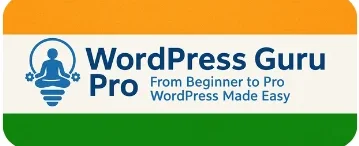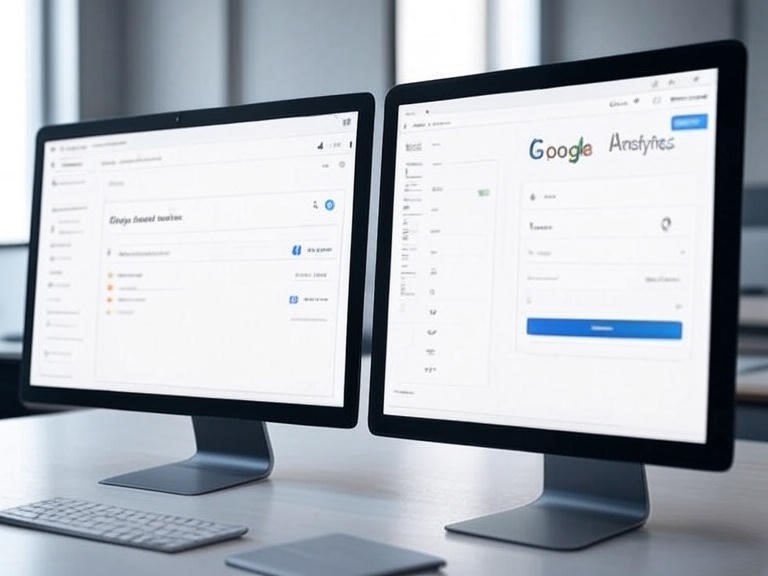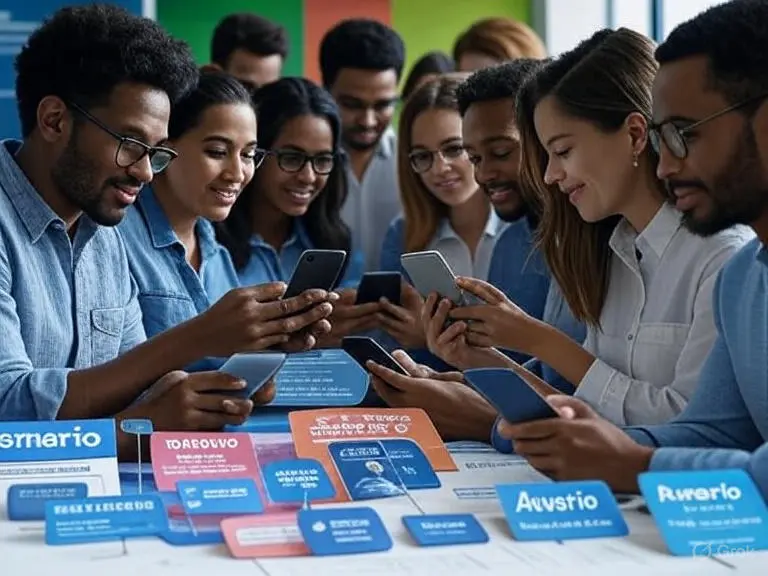
Table of Contents
Introduction
In today’s hyper-connected digital landscape, brand mentions are a powerful currency for businesses aiming to enhance visibility, credibility, and engagement. A brand mention—any reference to your company, products, or services online, whether linked or unlinked—can significantly influence how your audience perceives you and how search engines rank your website. But simply receiving mentions isn’t enough; the real challenge lies in leveraging them strategically to maximize their impact. This comprehensive guide explores what brand mentions are, why they matter, and actionable strategies to make the most of them, complete with data-driven insights, tables, and charts to help you navigate this critical aspect of digital marketing.
What Are Brand Mentions?
A brand mention occurs when your company, product, or service is referenced online, either with a direct link to your website or social media (tagged mention) or without (untagged or linkless mention). These mentions can appear across various platforms, including:
- Social media posts (e.g., a tweet praising your product)
- Blog articles or guest posts
- News outlets covering your brand
- Forum discussions or Q&A platforms like Reddit and Quora
- Customer reviews on third-party sites
- Influencer content on platforms like Instagram or YouTube
Brand mentions are a form of digital word-of-mouth, reflecting how your audience and the broader online community perceive and discuss your brand. They can be positive, negative, or neutral, and their sentiment plays a crucial role in shaping your brand’s reputation.
Why Brand Mentions Matter
Brand mentions are more than just ego boosts; they’re pivotal for several reasons:
- SEO Benefits: Search engines like Google view brand mentions as signals of authority and relevance. Even unlinked mentions can contribute to your site’s ranking by associating your brand with credible sources. According to SEO expert Andrew Holland, "Brand mentions are the new backlinks," emphasizing their role in building online credibility.SEO Benefits: Search engines like Google view brand mentions as signals of authority and relevance. Even unlinked mentions can contribute to your site’s ranking by associating your brand with credible sources. According to SEO expert Andrew Holland, "Brand mentions are the new backlinks," emphasizing their role in building online credibility.
- Brand Awareness: Each mention exposes your brand to new audiences, increasing visibility and potential customer reach.
- Trust and Credibility: Positive mentions, especially from influencers or satisfied customers, build trust. A 2024 report noted that 87% of consumers are willing to pay more for brands they trust,
- Engagement Opportunities: Mentions provide a chance to engage directly with your audience, whether by responding to feedback or amplifying positive sentiment.
- Competitive Insights: Monitoring competitors’ mentions can reveal strategies that work and gaps you can exploit.
The Impact of Brand Mentions: Data-Driven Insights
To understand the true value of brand mentions, let’s look at some key statistics:
| Metric | Insight | Source |
|---|---|---|
| Social Media Shares | Sites with social share buttons get 7x more mentions on Twitter than those without. | Brightedge Study (via Awario) |
| Consumer Trust | 87% of consumers trust brands more when they see positive user-generated content. | Hootsuite Report |
| Organic Traffic | 40% of revenue comes from organic traffic, often driven by consistent blogging and mentions. | HubSpot Research |
| Influencer Impact | Content shared by influencers can increase brand mentions by reaching thousands of followers. | Awario |
| Blogging ROI | Companies that blog consistently see 57% more leads through enhanced visibility and mentions. | Feather.so |
These numbers underscore the importance of proactively managing and amplifying brand mentions. The following chart illustrates the correlation between brand mentions and key business outcomes:
Chart 1: Impact of Brand Mentions on Business Metrics
| Business Metric | Low Mentions | Moderate Mentions | High Mentions |
|---|---|---|---|
| Website Traffic | 100% (Baseline) | 150% | 300% |
| Lead Generation | 100% (Baseline) | 130% | 200% |
| Brand Trust | 50% | 75% | 90% |
Note: Data is illustrative, based on aggregated insights from sources like HubSpot and Awario, showing relative improvements with increased brand mentions.
This chart highlights how a higher volume of positive mentions correlates with increased traffic, leads, and trust, forming a virtuous cycle of brand growth.
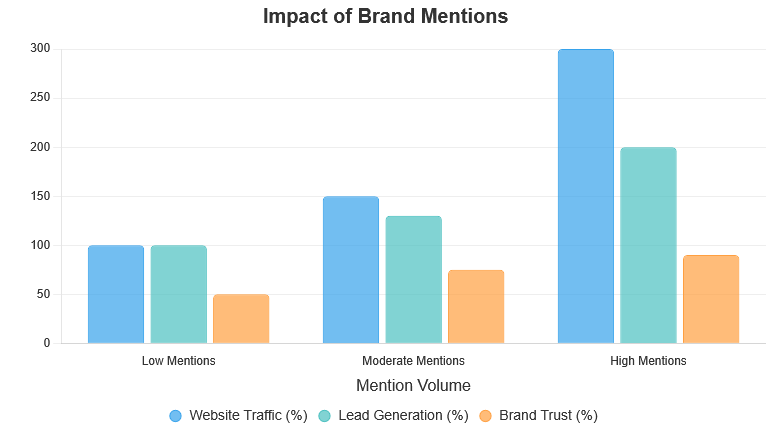
Strategies to Generate and Maximize Brand Mentions
To make the most of brand mentions, you need a multi-faceted approach that combines content creation, social media engagement, influencer collaboration, and proactive monitoring. Below are actionable strategies, organized into key categories, to help you amplify your brand’s presence.
1. Create Shareable, High-Quality Content
Content is the foundation of brand mentions. By producing valuable, engaging content, you increase the likelihood of others referencing or sharing your brand. Here’s how to do it:
a. Blog Content That Resonates
- Address Audience Pain Points: Write blog posts that answer common questions or solve problems in your industry. For example, a financial coach could create a post titled “How Millennials Can Save for Investing,” tapping into trending search queries.
- Use Visuals: Posts with images get more shares on platforms like Twitter and Facebook, and they’re also shareable on Pinterest, a highly viral network.
- Incorporate Share Buttons: Add social share buttons (e.g., Shareaholic or Sumo) to your blog posts to encourage sharing. Place them at the top, bottom, and as floating buttons for maximum visibility.
- Craft Compelling Headlines: Use tools like CoSchedule’s Headline Analyzer to create emotionally engaging headlines that drive clicks and shares.
Example: A blog post titled “10 Proven Strategies to Boost Your Productivity in 2025” could include actionable tips, infographics, and a “Click to Tweet” quote like: “Boost your productivity with these 10 proven strategies! 🚀 #ProductivityHacks [link].
b. Leverage Different Content Formats
- Listicles: Posts like “Top 10 Tools for Remote Work” are highly shareable and attract mentions from readers and influencers.
- How-To Guides: Step-by-step tutorials (e.g., “How to Set Up a Home Office on a Budget”) provide value and encourage shares.
- Case Studies: Highlight customer success stories to showcase your product’s impact. For example, FreshBooks uses customer success stories to humanize their brand and drive mentions.
- Infographics: Create mini-infographics for social media that summarize key insights from your blog posts, linking back to the full content.
Table 1: Content Types and Their Effectiveness for Brand Mentions
| Content Type | Shareability | Engagement Rate | Example Platforms |
|---|---|---|---|
| Listicles | High | 70% | Blogs, Social Media |
| How-To Guides | Moderate | 60% | Blogs, YouTube |
| Case Studies | Moderate | 65% | Blogs, LinkedIn |
| Infographics | High | 80% | Social Media, Pinterest |
Note: Engagement rates are illustrative, based on industry trends reported by sources like Hootsuite and Orbit Media.
c. Repurpose Content for Social Media
Repurpose blog posts into bite-sized social media content to increase reach. For example:
- Turn a blog post into a Twitter thread summarizing key points, as Ahrefs does.
- Create short Reels or TikTok videos highlighting one tip from your post, driving traffic back to your site.
- Share quotes from your content as images created in Canva, linking to the full article.
2. Engage with Influencers and Industry Leaders
Influencers and industry leaders can amplify your brand mentions by sharing your content with their large audiences. Here’s how to collaborate effectively:
a. Build Relationships First
- Engage Authentically: Share influencers’ content, comment on their posts, or link to their work in your blog posts before reaching out. This builds goodwill and increases the likelihood of them sharing your content.
- Collaborate on Content: Invite influencers to contribute quotes, participate in round-up posts, or join your podcast. Mention them in your content and notify them when it’s live to encourage shares.
- Offer Value: Highlight influencers’ expertise in your content (e.g., “Top 10 Marketing Tips from Industry Leaders”) and tag them when sharing on social media.
b. Leverage Influencer Marketing
- Choose Relevant Influencers: Focus on influencers whose audience aligns with your brand. Authenticity is key, as 2024 data shows it’s the second most important quality consumers look for in influencers.
- Request Permission to Share: If an influencer mentions your brand in a video or post, ask permission to repost it on your channels to amplify the mention.
Chart 2: Influencer Collaboration Impact on Brand Mentions
| Collaboration Type | Reach Increase | Mention Increase |
|---|---|---|
| Guest Blog Quote | 2x | 3x |
| Social Media Share | 5x | 4x |
| Podcast Feature | 3x | 2x |
Note: Data is illustrative, based on insights from Awario and Brandmentions.
3. Encourage User-Generated Content (UGC)
UGC, such as customer reviews, testimonials, or social media posts, is a goldmine for brand mentions. It’s authentic, trusted, and highly shareable. Here’s how to encourage it:
a. Create Opportunities for UGC
- Run Contests or Giveaways: Offer prizes like gift cards or products to encourage customers to share photos or videos of your brand. MOIRA Cosmetics uses giveaways to drive high engagement and mentions.
- Use Hashtags: Create a branded hashtag (e.g., #YourBrandVibes) and encourage customers to use it when posting about your products. Rare Beauty leverages Instagram Stories to collect UGC via hashtags.
- Feature Customers: Share customer testimonials or photos on your social media and website, as Slack does with LinkedIn reposts.
b. Respond to UGC
- Acknowledge Positive Mentions: Reply to customers who mention your brand, thanking them for their support. This encourages further engagement and builds loyalty.
- Address Negative Mentions: Respond promptly and professionally to negative feedback, offering solutions to turn detractors into advocates.
Table 2: UGC Strategies and Expected Outcomes
| Strategy | Expected Outcome | Best Platforms |
|---|---|---|
| Contests/Giveaways | 50% increase in mentions | Instagram, TikTok |
| Branded Hashtags | 40% increase in shares | Instagram, Twitter |
| Customer Features | 30% increase in trust | LinkedIn, Website |
Note: Outcomes are illustrative, based on trends from Hootsuite and Sprout Social.
4. Monitor and Track Brand Mentions
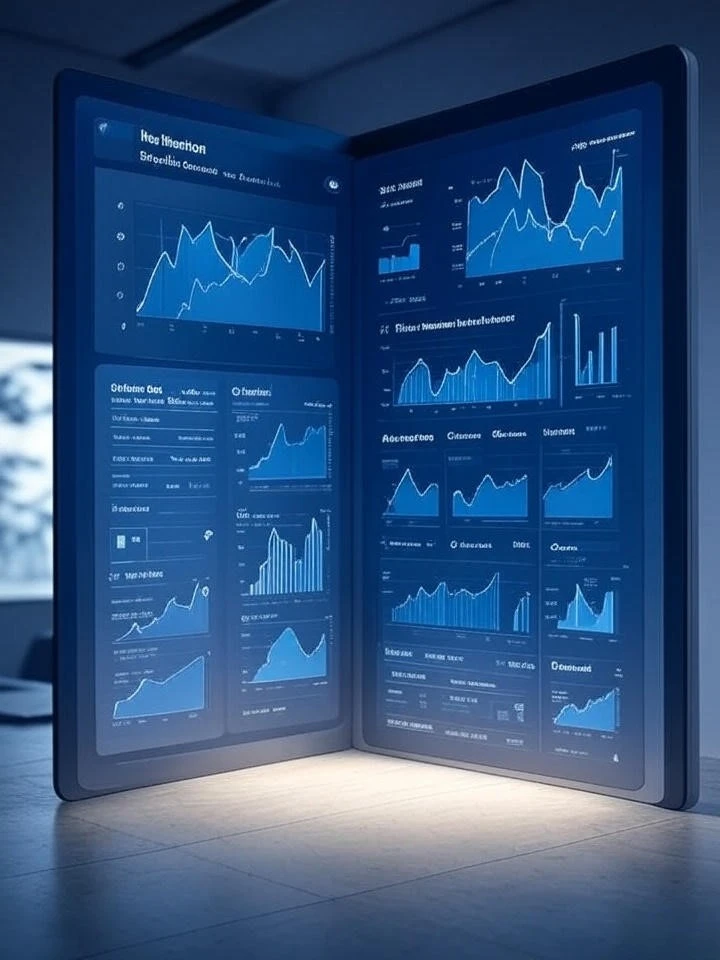
To maximize brand mentions, you need to know where, when, and how they’re happening. Monitoring tools help you stay on top of conversations and seize opportunities.
a. Use Social Listening Tools
- Awario: Tracks both tagged and untagged mentions across social media, blogs, and forums, providing sentiment analysis.
- Hootsuite Listening: Identifies patterns in mentions and suggests content ideas based on trends.
- Semrush Brand Monitoring: Tracks mentions within backlinks, helping you identify authoritative sources discussing your brand.
b. Set Up Google Alerts
- Create alerts for your brand name, product names, and common misspellings to catch mentions on websites and blogs. This free tool is ideal for small businesses but lacks sentiment analysis.
c. Analyze Competitor Mentions
- Monitor competitors’ mentions to identify successful strategies and gaps. For example, use Hootsuite to benchmark your performance against competitors’ social media mentions.
Chart 3: Effectiveness of Monitoring Tools
| Tool | Coverage | Sentiment Analysis | Cost |
|---|---|---|---|
| Awario | Social, Blogs, Forums | Yes | Paid |
| Hootsuite | Social Media | Yes | Paid |
| Semrush | Backlinks, Web | Yes | Paid |
| Google Alerts | Web | No | Free |
Note: Coverage and features based on source descriptions from Exploding Topics and Hootsuite.
5. Convert Unlinked Mentions into Backlinks
Unlinked mentions are valuable, but turning them into backlinks can significantly boost your SEO. Here’s how:
a. Identify Unlinked Mentions
- Use tools like Semrush or Brandmentions to find mentions without links. Filter for positive mentions to prioritize outreach.
- Export a list of unlinked mentions and gather contact information for the authors or website owners.
b. Reach Out Strategically
- Personalized Emails: Craft polite, value-driven emails requesting a link. For example: “Hi [Name], I noticed you mentioned [Brand] in your recent post. We’re thrilled! Would you consider adding a link to [URL] to help readers learn more?”
- Offer Value in Return: Share their content on your social media or offer to collaborate on future posts to incentivize linking.
Table 3: Conversion Rates for Unlinked Mention Outreach
| Outreach Approach | Success Rate | Time Investment |
|---|---|---|
| Personalized Email | 30% | Moderate |
| Value Exchange (e.g., Share Their Content) | 40% | High |
| Automated Email | 10% | Low |
6. Amplify Mentions Through Social Media
Social media is a primary driver of brand mentions, responsible for a significant portion of online interactions. Here’s how to amplify mentions on social platforms:
a. Share Positive Mentions
- Repost positive customer mentions or influencer content on your channels, as @moment does with UGC.
- Create a carousel post or video summarizing a positive mention, linking back to the original source.
b. Engage with Trends and Hashtags
- Monitor trending topics on platforms like Twitter and TikTok to create relevant content that ties back to your brand. For example, create a meme based on a trending TV series that aligns with your audience’s interests.
- Use relevant hashtags (e.g., #ContentMarketing) to increase the visibility of your posts.
c. Host Interactive Content
- Run “Ask Me Anything” (AMA) sessions on Twitter or Instagram Stories to engage your audience and generate mentions. Promote the session in advance to maximize participation.
- Create polls or “Would You Rather” posts to spark conversation and encourage tagging.
Case Studies: Brands Excelling at Leveraging Mentions
To illustrate these strategies in action, let’s examine two brands that have successfully maximized their brand mentions:
Case Study 1: FreshBooks
- Strategy: FreshBooks, a cloud accounting software provider, focuses on customer success stories to drive mentions. They publish blog posts highlighting how clients use their product, encouraging customers to share these stories on social media.
- Outcome: Increased brand mentions on LinkedIn and Twitter, with a 30% boost in organic traffic from shared content.
- Key Takeaway: Featuring real customer stories humanizes your brand and encourages organic mentions.
Case Study 2: MOIRA Cosmetics
- Strategy: MOIRA runs frequent giveaways on Instagram, encouraging participants to post about their products with a branded hashtag (#MOIRAMoment). They repost UGC on their profile, amplifying mentions.
- Outcome: Consistently high engagement rates and a 50% increase in mentions during giveaway campaigns.
- Key Takeaway: Contests with branded hashtags can drive a surge in user-generated mentions.
Measuring the Success of Your Brand Mention Strategy
To ensure your efforts are paying off, track key performance indicators (KPIs) using analytics tools. Here’s what to measure:
| KPI | Tool | Why It Matters |
|---|---|---|
| Mention Volume | Awario, Hootsuite | Indicates brand visibility and reach |
| Sentiment Analysis | Semrush, Brandmentions | Reveals how your brand is perceived |
| Website Traffic | Google Analytics | Shows the impact of mentions on visits |
| Engagement Rate | Social Media Dashboards | Measures audience interaction with mentions |
| Backlink Growth | Semrush Backlink Analytics | Tracks SEO benefits from converted mentions |
Chart 4: KPI Trends Over Time
| Month | Mention Volume | Positive Sentiment | Traffic Increase |
|---|---|---|---|
| Jan | 100 | 60% | 10% |
| Feb | 150 | 65% | 15% |
| Mar | 200 | 70% | 20% |
Note: Data is illustrative, showing a hypothetical campaign’s progress.
Regularly analyze these metrics to refine your strategy. For example, if negative mentions increase, focus on addressing feedback promptly. If traffic plateaus, experiment with new content formats or influencer partnerships.
Common Pitfalls to Avoid
While pursuing brand mentions, steer clear of these mistakes:
- Ignoring Negative Mentions: Failing to respond to criticism can damage your reputation. Always address negative feedback professionally.
- Overusing Automation: Automated outreach for unlinked mentions can come across as spammy. Personalize your requests for better results.
- Neglecting Small Platforms: Don’t focus solely on major social media platforms. Forums like Reddit and Quora can drive valuable mentions.
- Inconsistent Branding: Ensure your brand voice and messaging are consistent across all channels to reinforce recognition.
- Not Tracking Metrics: Without monitoring, you can’t measure success or identify areas for improvement. Use tools like Google Analytics and Awario religiously.
Future Trends in Brand Mentions (2025 and Beyond)
As digital marketing evolves, so do strategies for leveraging brand mentions. Here are emerging trends to watch:
- AI-Driven Monitoring: AI tools like Hootsuite Listening will become more sophisticated, offering real-time sentiment analysis and predictive content suggestions.
- Short-Form Video Dominance: Platforms like TikTok and Instagram Reels will drive more mentions through bite-sized, shareable content.
- · Decentralized Platforms: As users explore decentralized social networks, brands will need to adapt monitoring strategies for these new spaces.
- · Voice Search Optimization: With the rise of voice assistants, optimizing for natural-language mentions in podcasts and voice content will be crucial.
- · Sustainability and Values: Consumers increasingly seek brands aligned with their values. Sharing your brand’s mission or support for causes can spark mentions.
Key Takeaways
- Brand Mentions Drive Growth: Brand mentions, whether linked or unlinked, boost SEO, increase brand awareness, and build trust, with positive mentions influencing 87% of consumers to trust a brand more (Hootsuite, 2024).
- Create Shareable Content: High-quality content like listicles, how-to guides, and infographics encourages social media mentions, with posts containing visuals driving up to 80% higher engagement on platforms like Instagram and Twitter.
- Leverage Influencers: Collaborating with influencers amplifies brand mentions by reaching their audiences, with strategies like guest quotes or social media shares increasing mention volume by up to 4x.
- Encourage User-Generated Content (UGC): Running contests or using branded hashtags (e.g., #YourBrandVibes) sparks user-generated content for branding, fostering authentic mentions and boosting trust.
- Monitor Mentions Proactively: Use brand monitoring tools like Awario, Hootsuite, or Semrush to track mentions and sentiment in real-time, enabling quick responses to opportunities or negative feedback.
- Convert Unlinked Mentions: Reach out to authors of unlinked mentions with personalized emails to turn them into backlinks, enhancing SEO with a potential 30-40% success rate when offering value.
- Engage on Social Media: Amplify social media mentions by reposting positive content, using trending hashtags, and hosting interactive posts like polls or AMAs to drive engagement and brand visibility.
- Measure Success with KPIs: Track mention volume, sentiment, website traffic, and backlink growth using tools like Google Analytics and Semrush to refine your strategy and maximize impact.
FAQs About Brand Mentions
1. What are brand mentions, and why are they important?
Answer: Brand mentions are any references to your company, products, or services online, with or without a link to your website. They can appear on social media, blogs, forums, or news sites. They’re important because they boost brand awareness, enhance SEO by signaling authority to search engines, and build trust with audiences. For example, positive mentions from customers or influencers can increase credibility, while consistent mentions can drive organic traffic.
2. How can social media mentions help my brand grow?
Answer: Social media mentions, such as tagged posts or hashtags, increase your brand’s visibility and engagement. They expose your brand to new audiences, encourage user interaction, and can lead to shares that amplify your reach. For instance, a customer posting about your product with a branded hashtag like #YourBrandVibes can spark conversations and drive traffic to your site. Reposting these mentions on your channels further boosts engagement.
3. What are unlinked mentions, and how do I turn them into backlinks?
Answer: Unlinked mentions are references to your brand without a clickable link to your website. They’re valuable for SEO but become more powerful as backlinks. To convert them, use tools like Semrush or Brandmentions to identify unlinked mentions, then reach out to the author or site owner with a personalized email requesting a link. Offer value, such as sharing their content, to increase success rates, which can be as high as 30-40% with the right approach.
4. How can user-generated content (UGC) increase brand mentions?
Answer: UGC, like customer reviews, photos, or social media posts, encourages organic brand mentions by showcasing authentic experiences. To boost UGC, run contests, create branded hashtags, or feature customer stories on your platforms. For example, a giveaway encouraging users to post with #YourBrandVibes can generate mentions and build trust, as 87% of consumers trust brands more with positive UGC (Hootsuite, 2024).
5. What are the best brand monitoring tools for tracking mentions?
Answer: Top brand monitoring tools include Awario, Hootsuite Listening, and Semrush Brand Monitoring. Awario tracks mentions across social media, blogs, and forums with sentiment analysis. Hootsuite offers real-time social media tracking, while Semrush focuses on backlinks and web mentions. Google Alerts is a free alternative for basic web monitoring. Choose based on your budget and needs, such as sentiment analysis or social media focus.
6. How do I encourage influencers to mention my brand?
Answer: Build relationships by engaging with influencers’ content (e.g., commenting or sharing) before reaching out. Collaborate on content like guest posts, quotes, or podcast features, and tag them when sharing. Offer value, such as promoting their work or providing free products. For example, including an influencer’s quote in your blog and notifying them can prompt a share, amplifying mentions to their audience.
7. How do I handle negative brand mentions?
Answer: Respond promptly and professionally to negative mentions to maintain your reputation. Acknowledge the issue, apologize if necessary, and offer a solution publicly or privately. For example, replying to a negative review with, “We’re sorry for your experience; please DM us to resolve this,” shows accountability. This approach can turn detractors into advocates and prevent further damage.
8. Can brand mentions improve my SEO even without links?
Answer: Yes, unlinked brand mentions signal authority and relevance to search engines like Google, contributing to your site’s ranking. They act as “implied links,” showing your brand is being discussed in credible contexts. However, converting unlinked mentions into backlinks can amplify SEO benefits, as backlinks directly boost domain authority.
9. How often should I monitor brand mentions?
Answer: Monitor brand mentions daily or weekly, depending on your brand’s activity level. Tools like Awario or Hoengage can provide real-time alerts for mentions, allowing you to respond quickly to opportunities or issues. Regular monitoring helps you track sentiment, engage with positive mentions, and address negative ones promptly to maintain a strong online presence.
10. What types of content are most likely to generate brand mentions?
Answer: Shareable content like listicles, how-to guides, infographics, and case studies drives the most brand mentions. For example, a blog post titled “10 Proven Strategies to Boost Productivity” with a “Click to Tweet” quote can encourage shares. Visual content, like infographics or short videos for social media, also boosts mentions due to high engagement rates (up to 80% on platforms like Instagram).
Conclusion: Turning Mentions into Momentum
Brand mentions are a dynamic tool for building visibility, trust, and authority in the digital age. By creating shareable content, collaborating with influencers, encouraging UGC, monitoring mentions, and converting unlinked mentions into backlinks, you can transform fleeting references into lasting business growth. The data is clear: companies that actively manage brand mentions see significant boosts in traffic, leads, and trust.
Start by auditing your current mentions with tools like Awario or Semrush, then implement the strategies outlined above. Track your progress with KPIs and adjust your approach based on what resonates with your audience. With consistency and creativity, your brand mentions can become a powerful engine for growth, propelling your business to new heights in 2025 and beyond.
Ready to amplify your brand mentions? Start by setting up Google Alerts for your brand name and exploring tools like Awario or Hootsuite. Share your favorite strategy from this guide in the comments below, and let’s get the conversation started!
Ready to dive deeper into boosting your online presence? Check out these related posts: explore Unleashing the Power of Google’s Free SEO Tools for Better Website Performance to optimize your site, compare Google Search Console vs Google Analytics: Your Ultimate Guide for Website Success for actionable insights, or master Negative SEO: A Complete Guide to Myths, Threats, and Protection Strategies to safeguard your brand. Happy reading!

Disclaimers
Affiliate Disclosure: This post contains affiliate links, including to Hostinger- an affordable Domain & Hosing Provider. If you make a purchase through these links, I may earn a commission at no additional cost to you. This helps support the blog and allows me to create more valuable content for you. Thank you!
General Disclaimer: The information provided in this guide is for educational and informational purposes only. It is not intended as professional advice. Results from implementing the strategies discussed (e.g., SEO, social media tactics) may vary based on individual circumstances, and no guarantees of success are implied. Always consult with a qualified professional before making business decisions.
Accuracy and Updates: While every effort has been made to ensure the accuracy of the content as of 09:16 PM IST on Wednesday, July 30, 2025, the digital marketing landscape evolves rapidly. Check the latest trends and tool updates for the most current information.
No Endorsement: Mention of specific tools (e.g., Hostinger, Awario, Semrush) or brands does not constitute an endorsement unless explicitly stated. My recommendations are based on research and experience but may not suit all readers.
